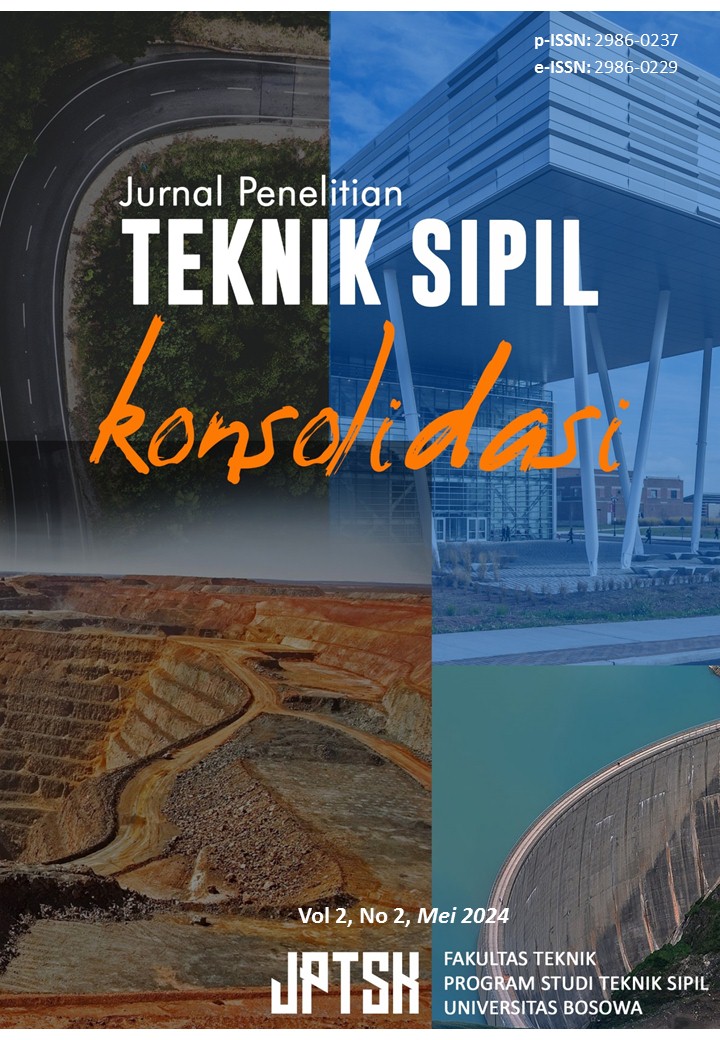Pengaruh Penggunaan Abu Batang Pisang Dan Abu Cangkang Sawit Ditambah Sikacim Concrete Additive Terhadap Kuat Tekan Beton
DOI:
https://doi.org/10.56326/jptsk.v2i2.3266Keywords:
Abu Batang Pisang, Abu Cangkang Sawit, Sikacim Concrete Additive, Kuat TekanAbstract
Research on increasing the compressive strength of concrete by using various types of additives has been widely carried out, so this research also uses additives, namely the use of banana stem ash and palm shell ash, which aims to determine the comparison of the two additives, as well as the effect of adding concrete. Contains Sikacim Concrete Additive. Variations in banana stem ash and palm shell ash (4%, 5% and 6%) of the cement weight as well as the addition of Sikacim Concrete Additive as much as 0.6% of the cement weight. The average compressive strength of the concrete samples was measured and compared. The research results showed that the higher the percentage of banana stem ash and palm shell ash used, the higher the compressive strength of the concrete produced. The compressive strength of variations in banana stem ash is greater than variations in palm shell ash with percentages of 14.13%, 11.17% and 7.08. The effect of adding sikacim concrete on banana stem ash was 3.17%, 1.39%, 6.73 and on palm shell ash was 2.88%, 4.32%, 3.99% compared to before adding sikacim. Banana stem ash at a percentage of 6% with the addition of sikacim had the highest increase with a compressive strength of 29.91 Mpa.
References
Alkhaly, Y. R., Panondang, C. N., & Zulfahmi, Z. (2021). Kuat Tekan Beton Polimer Berbahan Abu Vulkanik Gunung Sinabung Dan Resin Epoksi. Teras Jurnal: Jurnal Teknik Sipil, 5(2).
Badan Standarisasi Nasional Indonesia. (2013). SNI 2847:2013 Persyaratan Beton Struktural untuk Bangunan Gedung. Bsn, 265.
Dedi, M. (2004). Skripsi” Pengaruh Abu Cangkang Kelapa Sawit Terhadap Kuat Tekan Beton”. Fakultas Teknik Universitas Islam Riau, Riau.
Desmi, A. (2018). Pengaruh Penggunaan Abu Jerami Dengan Penambahan Zat Additive Sikacim Concrete Terhadap Kuat Tekan Beton. Journal Terrace, 8(1), 339–349.
Ghafur, A. (2009). Pengaruh Penggunaan Abu Ampas Tebu Terhadap Kuat Tekan Dan Pola Retak Beton (Kajian Eksperimental). Universitas Sumatera Utara.
Jamal, M., Widiastuti, M., & Anugrah, A. T. (2018). Pengaruh penggunaan Sikacim Concrete Additive terhadap kuat tekan beton dengan menggunakan agregat kasar bengalon dan agregat halus pasir Mahakam. Seminar Nasional Rekayasa Tropis 2023, 1(1), 28–36.
Karwur, H. Y., Tenda, R., Wallah, S. E., & Windah, R. S. (2013). Kuat tekan beton dengan bahan tambah serbuk kaca sebagai substitusi parsial semen. Jurnal Sipil Statik, 1(4).
Mulyono, T. (2004). Teknologi beton. Penerbit Andi, Yogyakarta.
Nasional, B. S. (2000). Tata cara pembuatan rencana campuran beton normal. SK SNI, 3, 2000–2834.
Novrianti, R. R., & Muda, A. (2014). Pengaruh Aditif Sikacim Terhadap Campuran Beton K 350 Ditinjau Dari Kuat Tekan Beton. Civil Scientific Media, 2, 64–69.
Pujo, A., & Purwono, R. (2010). Pengendalian Mutu Beton. Itspress Surabaya.
Setiawan, A. (2016). Perancangan struktur beton bertulang berdasarkan SNI 2847: 2013. Jakarta: Erlangga, 301.
Sidik, S., Rahman, R., Sukma, A. M., & Nurwidayati, R. (n.d.). Pengaruh Abu Cangkang Kelapa Sawit Sebagai Pengganti Semen Terhadap Kuat Tekan Beton NormaL.
Suratmin, S., Satyarno, I., & Tjokrodimuljo, K. (2007). Pemanfaatan Kulit Ale-Ale sebagai Agregat Kasar dalam Pembuatan Beton. Civil Engineering Forum Teknik Sipil, 17(2), 530–538.
Wahyudi, T., Edison, B., & Ariyanto, A. (2013). Penggunaan Ijuk Dan Sabut Kelapa Terhadap Kuat Tekan Pada Beton K-100. Universitas Pasir Pengaraian
Downloads
Published
Issue
Section
License
Copyright (c) 2024 Hizkia Rial Alloto'dang, Syahrul Sariman, Arman Setiawan

This work is licensed under a Creative Commons Attribution 4.0 International License.










